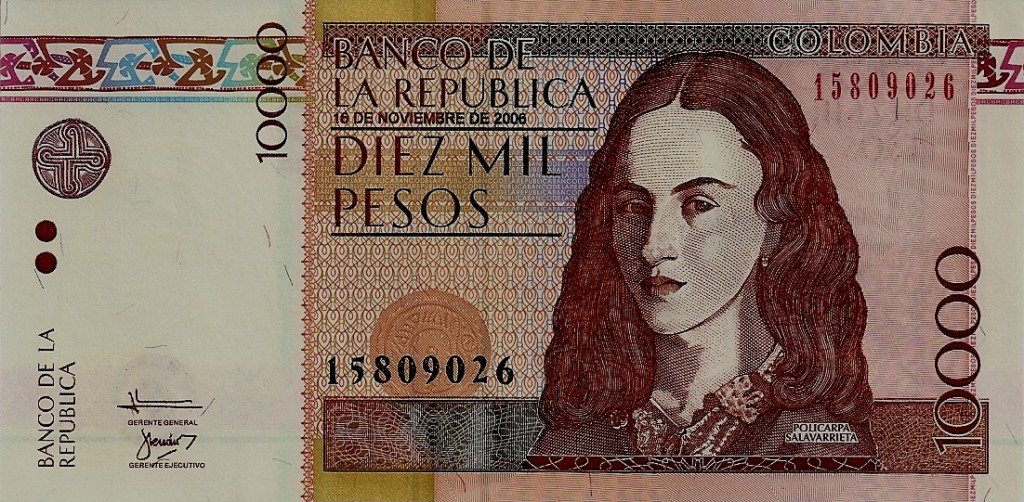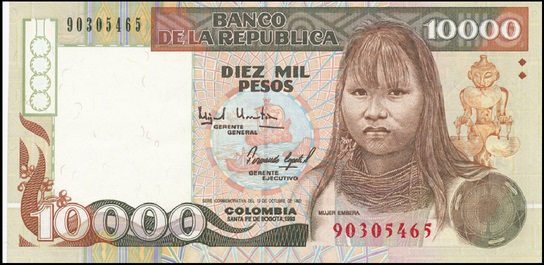
In the rich tapestry of Colombia’s banknote history, four out of the 26 notes circulated in the country have showcased the image of a woman on their obverse.
Crafting a banknote is a nuanced artistic challenge. The selection of designs, patterns, personalities, colors, and other elements encapsulates a snapshot of the historical moment when they are issued and enter circulation.
Various independence heroes, former presidents, male scientists, writers, and poets have graced 22 out of the 26 banknotes in circulation since 1963. Only on four occasions has a female image taken center stage on the obverse side of the bills. Let’s delve into the identities behind these iconic representations.
Policarpa Salavarrieta
The trailblazer, Policarpa Salavarrieta, was the first woman to feature on a Colombian banknote. She made her debut on the two-peso gold note in the inaugural family of banknotes issued by the Banco de la Republica in 1963. Thirty years later, in 1995, she reappeared on the 10,000-peso note.
Known as La Pola, Policarpa Salavarrieta is hailed as an independence heroine for her espionage efforts on behalf of the Creole independence forces during the Spanish reconquest. She began her political activities at the age of 15, participating in the cry for independence on July 20. Later, in Bogota, she joined the patriot army, serving as a spy’s right hand.
Her inconspicuous presence allowed her to move through the streets undetected. One of her tasks was to sew for the wives of royalists, gathering intelligence on news, troop movements, and enemy orders, providing patriots with a strategic advantage. She also served as a messenger, delivering letters between armies, and assisted in arming the patriots.
Her life met its end following the arrest of patriot Alejo Sabarain. Lists and letters found among his possessions included names of both royalists and patriots, including Policarpa. She was captured and sentenced to death on November 14, 1817, at the age of 22.
Embera Indigenous Woman
An indigenous woman graced the obverse of the first 10,000-peso gold note, issued in commemoration of the 500 years since the arrival of the Spanish in America on October 12, 1492. The serene visage belonged to a woman from the Embera community, known for their resistance to conquests until the 17th century. The note also featured a representative Quimbaya goldwork figure and two vessels, symbolizing the arrival of the conquistadors.

Debora Arango
Since 2016, the face of the 2,000-peso note has been adorned by Debora Arango Perez, an Antioquian expressionist painter, watercolorist, and ceramist. Arango distinguished herself by being the first to paint and exhibit female nudes, attracting social critique with a style that opposed academic dogmas.
From a young age, Arango displayed an inclination for painting, influenced by her elder brothers, who were doctors, teaching her anatomy while their sister served as a model.
In 1932, Arango joined the Institute of Fine Arts in Medellin, becoming a disciple of Antioquian artist Eladio Velez and, three years later, Pedro Nel Gomez. Together, they defined and matured artistic values, forging her expressionist style. Despite facing criticism and censorship for including female nudes in her works, Arango continued her artistic journey in the United States, Mexico, and Spain. Upon her return in 1948, she created controversial pieces inspired by political turmoil, depicting figures from Colombian politics using animals.
Despite initial censure, Arango’s rebellious and bold artistic contributions earned her recognition in 1975, when she received 12 decorations, including the Arts and Letters Award from the Government of Antioquia, the Boyaca Cross, and an Honorary Doctorate from the University of Antioquia.
Virginia Gutierrez de Pineda
Virginia Gutierrez de Pineda, a Santanderan anthropologist, paved the way for research on family and medical anthropology in Colombia. Her early ethnological training led her to focus on studying indigenous groups in Santander, Choco, and La Guajira, and later to delving into cultural aspects of diseases and traditional medicine in the country.
In 1956, she became a full-time professor at the National University of Colombia, where she taught for 30 years. Her dedication to family studies, using historical and ethnographic methods, resulted in notable academic works reflecting on gender roles, environmental influence, socioeconomic stratification, and historical transformations.
Her significant works include “Family and Culture in Colombia,” “Honor, Family, and Society: Patriarchy in Santander,” “Folk Medicine in Colombia: Reasons for Its Root,” and “Traditional Medicine in Colombia: Magic, Religion, and Folk Healing – The Triple Legacy.”
Elected Woman of the Year in 1976, Virginia Gutierrez de Pineda became the face of the current 10,000-peso note in 2016, commemorating her pioneering contributions to Colombian anthropology.
See all the latest news from Colombia and the world at ColombiaOne.com. Contact our newsroom to report an update or send your story, photos and videos. Follow Colombia One on Google News, Facebook, Instagram, and subscribe here to our newsletter.

